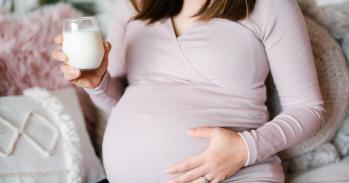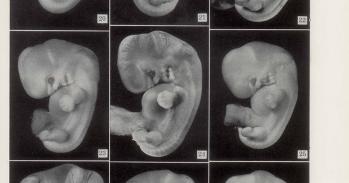
New research provides the first clear evidence that the amount of nutrients transported to the foetus by the placenta adjusts according to both the foetal drive for growth, and the mother’s physical ability to provide.
New research provides the first clear evidence that the amount of nutrients transported to the foetus by the placenta adjusts according to both the foetal drive for growth, and the mother’s physical ability to provide.
During pregnancy there is a kind of ‘tug-of-war’ going on between the mother and the foetus over who gets the nutrients that the mother ingests. This work shows for the first time that the placenta is the umpire which controls that fight
Amanda Sferruzzi-Perri
Researchers have shown for the first time how the placenta “umpires” a fight for nutrients between a pregnant mother and her unborn baby. The study suggests that the placenta will adjust the amount of nutrients transported to the foetus for growth in line with the mother’s physical ability to supply.
The findings, published in the journal PNAS, suggest that if the bodily environment that a mother provides for her baby is unfavourable, for example through small body size or metabolic dysfunction, the placenta will change the flow of nutrients to the foetus relative to her own state. This can affect foetal development, resulting in complications at birth.
It is the first time that scientists have been able to provide clear evidence that the placenta plays the decisive role in this delicate balancing act, rather than merely acting as a passive interface which enables the transfer of nutrients from mother to foetus.
The study, by researchers at the University of Cambridge, involved making a precise genetic change in mice, which caused poor growth and changed the mother’s bodily environment. They then observed how the placenta developed and acted in response, finding that in mothers in which this alteration had been made, the structure of the placenta was different, and fewer nutrients reached the foetus.
A better understanding of how the placenta manages the trade-off will eventually enable researchers to reduce pregnancy complications in both humans and other mammals.
The study was led by Dr Amanda Sferruzzi-Perri, a Research Associate at St John’s College, University of Cambridge, and is part of a five-year project in the Department of Physiology, Development and Neuroscience examining the relationship between the placenta and pregnancy complications.
“During pregnancy there is a kind of ‘tug-of-war’ going on between the mother and the foetus over who gets the nutrients that the mother ingests,” Sferruzzi-Perri said. “This work shows for the first time that the placenta is the umpire which controls that fight. Understanding more about the placenta’s role is extremely important. If nutrients cannot be divided correctly during pregnancy, it can lead to life-threatening complications for expectant mothers, and long-term health consequences for both mother and child.”
At least one in every eight pregnancies in the UK is affected by complications stemming from impairment of the placenta. In the developing world the rate is even higher, with at least one in every five pregnant women affected. The potential consequences include abnormal birth weight, premature delivery, pre-eclampsia, and maternal diabetes.
A major cause appears to be the placenta’s response to unfavourable biological changes in the mother herself. These may, for example, be the result of poor nutrition, high stress levels, metabolic dysfunction, or obesity.
How the placenta allocates nutrients in these situations, however, and the hormonal signals that the placenta may be releasing while doing so, is not fully understood. By understanding these processes better, researchers hope to identify both the biological early warning signals that a problem has arisen, and their relationship to specific causes, enabling them to develop therapeutic interventions that reduce the number of complications overall.
The new study represents a step towards those aims because researchers were able to directly influence the balancing act that the placenta performs and observe it in relation to both the physiology of the mother, and the actual growth and nutrient supply of the foetus.
To achieve this they used a model system where an enzyme called p110 alpha was genetically modified in mice. In a healthy mother, this enzyme is activated by hormones like insulin and insulin-growth factors (IGFs), kick-starting a relay race within cells which stimulates nutrient uptake and, as a result, normal growth and metabolic function. By altering this enzyme, the team reduced the mother’s overall responsiveness to such hormones, creating an unfavourable environment.
The results showed that in mothers which carried the altered form of p110 alpha, the placenta’s growth and structure was impaired. As well as being physically different, it was also found to be transporting fewer nutrients to the unborn offspring.
Because of the way in which the experiments were set up, the team were also able to see what would happen to the placenta if the foetus carried the altered form of p110 alpha, but the mother was normal. They found that in these cases, the placenta also showed defects, but was able to compensate for this by transporting more nutrients to the foetus, and thus optimising nutrition.
This shows that the placenta will fine-tune the distribution of nutrients between the mother and foetus, in response to the circumstances in which it finds itself. It also indicates that, because the mother needs to be able to support her baby both during pregnancy and after birth, the placenta will do its best to judge how much nutrition the foetus receives, so that the mother’s health is not compromised.
“The placenta is taking in signals all the time from the mother and the foetus,” Sferruzzi-Perri explained. “If the mother has some sort of defect in her ability to grow, the placenta will limit the amount of nutrients it allocates to the foetus to try and preserve her health.”
“What this tells us is that the mother’s environment is a very strong, modifiable characteristic to which we should be paying more attention, in particular to see if there are specific factors that we can change to improve the outcome of pregnancies. Being able to influence the mother’s environment through changes in p110 alpha gives us a means to study this in a controlled way, and to work out what those critical factors are.”
The next stage of the research will involve examining the signals that the placenta sends to the mother to affect the way she uses the nutrients she ingests, potentially providing important clues about biomarkers which provide an early warning of pregnancy complications.
Dr Sferruzzi-Perri’s research is supported by a Dorothy Hodgkin Fellowship from the Royal Society. Her paper, Maternal and fetal genomes interplay through phosphoinositol 3-kinase(PI3K)-p110α signalling to modify placental resource allocation, is published in PNAS. The work was supported by a Next Generation Fellowship from the Centre for Trophoblast Research.

The text in this work is licensed under a Creative Commons Attribution 4.0 International License. For image use please see separate credits above.




